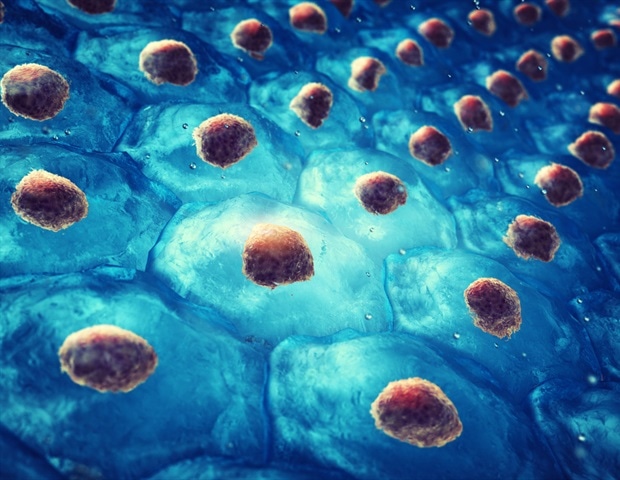
It is no secret that our waistlines usually develop in middle-age, however the issue is not strictly beauty. Stomach fats accelerates ageing and slows down metabolism, rising our threat for creating diabetes, coronary heart issues and different continual illnesses. Precisely how age transforms a six pack right into a softer abdomen, nonetheless, is murky.
Now preclinical analysis by Metropolis of Hope®, one of many largest and most superior most cancers analysis and remedy organizations in america and a number one analysis heart for diabetes and different life-threatening diseases, has uncovered the mobile perpetrator behind age-related belly fats, offering new insights into why our midsections widen with center age. Printed at present in Science, the findings counsel a novel goal for future therapies to stop stomach flab and lengthen our wholesome lifespans.
“Folks usually lose muscle and acquire physique fats as they age-even when their physique weight stays the identical,” mentioned Qiong (Annabel) Wang, Ph.D., the research’s co-corresponding writer and an affiliate professor of molecular and mobile endocrinology at Metropolis of Hope’s Arthur Riggs Diabetes & Metabolism Analysis Institute, one of many world’s foremost scientific organizations devoted to investigating the biology and remedy of diabetes. “We found ageing triggers the arrival of a brand new sort of grownup stem cell and enhances the physique’s huge manufacturing of latest fats cells, particularly across the stomach.”
In collaboration with the UCLA laboratory co-corresponding writer Xia Yang, Ph.D., the scientists carried out a sequence of mouse experiments later validated on human cells. Wang and her colleagues targeted on white adipose tissue (WAT), the fatty tissue chargeable for age-related weight acquire.
Whereas it is well-known that fats cells develop bigger with age, the scientists suspected that WAT additionally expanded by producing new fats cells, which means it might have a limiteless potential to develop.
To check their speculation, the researchers targeted on adipocyte progenitor cells (APCs), a gaggle of stem cells in WAT that evolve into fats cells.
The Metropolis of Hope workforce first transplanted APCs from younger and older mice right into a second group of younger mice. The APCs from the older animals quickly generated a colossal quantity of fats cells.
When the workforce transplanted APCs from younger mice into the older mice, nonetheless, the stem cells didn’t manufacture many new fats cells. The outcomes confirmed that older APCs are geared up to independently make new fats cells, no matter their host’s age.
Utilizing single-cell RNA sequencing, the scientists subsequent in contrast APC gene exercise in younger and older mice. Whereas barely lively in younger mice, APCs wakened with a vengeance in middle-aged mice and started pumping out new fats cells.
Whereas most grownup stem cells’ capability to develop wanes with age, the other holds true with APCs – ageing unlocks these cells’ energy to evolve and unfold. That is the primary proof that our bellies develop with age as a result of APCs’ excessive output of latest fats cells.”
Adolfo Garcia-Ocana, Ph.D., the Ruth B. & Robert Okay. Lanman Endowed Chair in Gene Regulation & Drug Discovery Analysis and chair of the Division of Molecular & Mobile Endocrinology at Metropolis of Hope
Growing old additionally remodeled the APCs into a brand new sort of stem cell referred to as dedicated preadipocytes, age-specific (CP-As). Arising in center age, CP-A cells actively churn out new fats cells, explaining why older mice acquire extra weight.
A signaling pathway referred to as leukemia inhibitory issue receptor (LIFR) proved important for selling these CP-A cells to multiply and evolve into fats cells.
“We found that the physique’s fat-making course of is pushed by LIFR. Whereas younger mice do not require this sign to make fats, older mice do,” defined Wang. “Our analysis signifies that LIFR performs a vital function in triggering CP-As to create new fats cells and develop stomach fats in older mice.”
Utilizing single-cell RNA sequencing on samples from individuals of assorted ages, Wang and her colleagues subsequent studied APCs from human tissue within the lab. Once more, the workforce additionally recognized related CP-A cells that had an elevated quantity in middle-aged individuals’s tissue. Their discovery additionally illustrates that CP-As in people have excessive capability in creating new fats cells.
“Our findings spotlight the significance of controlling new fat-cell formation to deal with age-related weight problems,” mentioned Wang. “Understanding the function of CP-As in metabolic problems and the way these cells emerge throughout ageing may result in new medical options for lowering stomach fats and bettering well being and longevity.”
Future analysis will deal with monitoring CP-A cells in animal fashions, observing CP-A cells in people and creating new methods that remove or block the cells to stop age-related fats acquire.
The research’s first authors are Metropolis of Hope’s Guan Wang, Ph.D., and UCLA’s Gaoyan Li, Ph.D.
Supply:
Journal reference:
Wang, G., et al. (2025). Distinct adipose progenitor cells rising with age drive lively adipogenesis. Science. doi.org/10.1126/science.adj0430.
